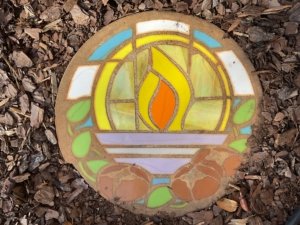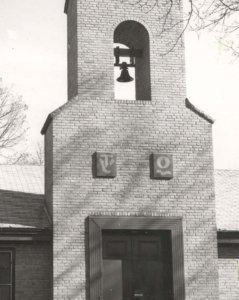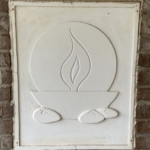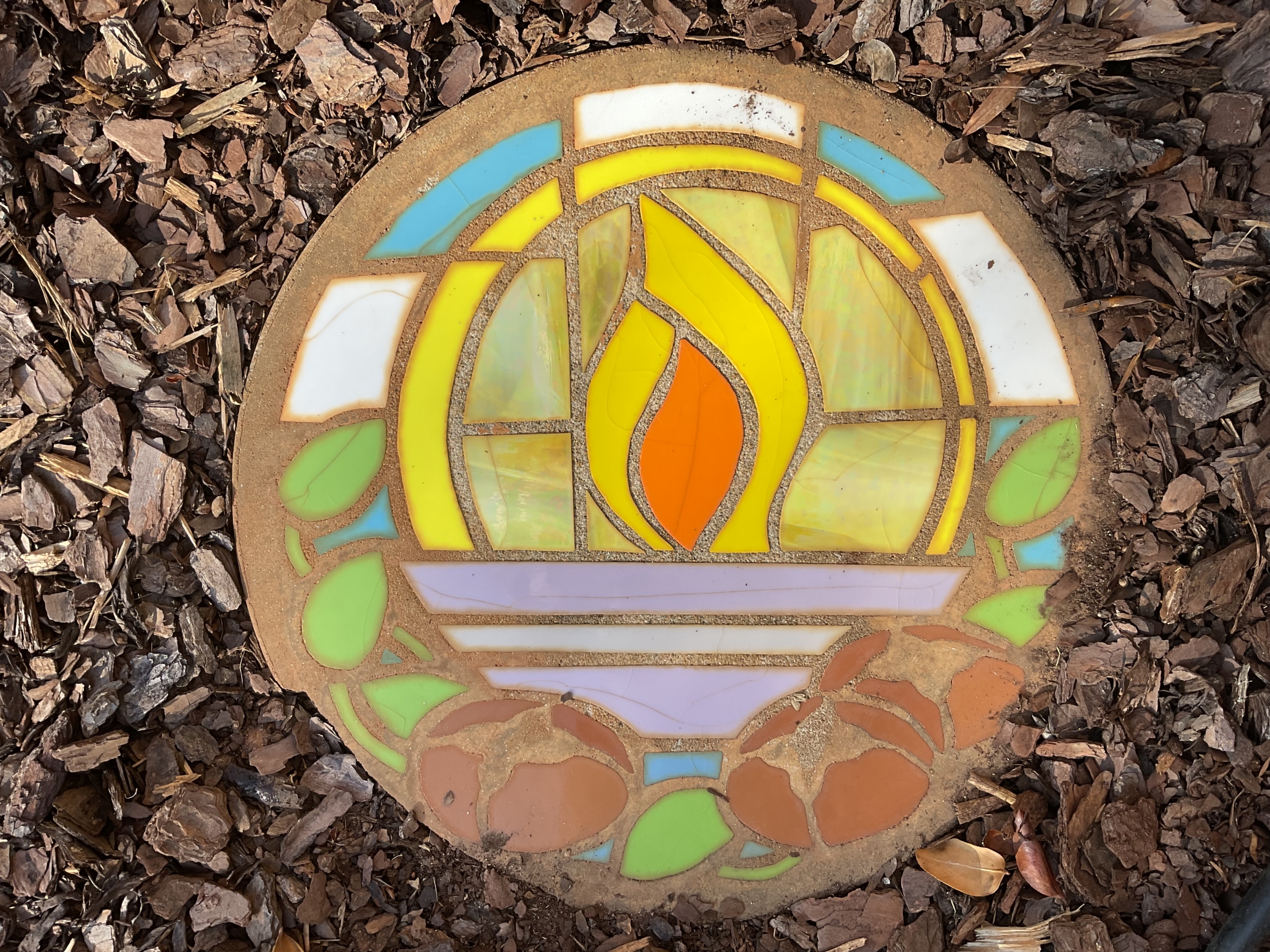
The logo itself is based on a symbol that was designed by one of our sisters. This symbol reflects our heritage, and our use of it has grown as our community has developed and grown. It’s important to understand not only what the logo means but also why we began using it.
What does it mean?
You won’t be surprised to learn that symbol represents St. Clare of Assisi. In addition, it illustrates two miracles that she performed during her lifetime.
There are two parts to the symbol: in the background is an oil lamp, with a flame; in the foreground are three loaves of bread, each with a cross on top (much like hot cross buns).

Tile created by David Zelinsky
The oil lamp with its prominent flame represents Clare. When Clare’s mother was pregnant with her, she visited a church to pray for a safe delivery and “heard a voice telling her: ‘You will give birth to a light that will shine brilliantly in the world.’”1 She therefore named her child Clare — Chiara in Italian — which means “light.” Indeed, when Clare became a nun, she was described as being “on fire with the flame of charity.”2 Sr. Filippa, one of the sisters in Clare’s monastery, reported seeing a bright light, so strong that “she believed it was the flame of an actual fire” above the place where Clare prayed.3 There is also the legend of Francis and Clare meeting at the Portiuncula and sharing a meal; as they spoke of and worshiped God, they were enveloped in a light that was so intense that the people of Assisi thought that the church and woods surrounding it were on fire.4 Of course, the source of Clare’s light was Christ, the Light of the World (Jn 8:12, 9:5); as a follower of Christ, she too is a “light of the world” whose “light so shine[s] before men, that they may see … [her] good works and give glory to our Father in heaven” (Mt 5:14).
The loaves of bread in the foreground of our logo are signs of the Paschal Mystery, and, in particular, of the Passion and Resurrection of Christ celebrated in the Eucharist. The Eucharist was central to Clare’s spirituality; even though she and her sisters only received communion seven times a year,5 they prayed daily before Christ’s Real Presence. She urged her sisters to “Gaze upon that mirror each day,”6 reflecting on Christ’s poverty, humility, and “ineffable charity” in suffering and dying on the cross for us.7 “May you totally love Him / Who gave Himself totally for your love,” she wrote St. Agnes of Prague.8 Her devotion to the Eucharist was also evident in many of the miracles attributed to her during her lifetime. She healed the sick by making the sign of the cross over them, for example, and drove the Saracens away from both the monastery and Assisi by praying with the pyx containing the Blessed Sacrament (not with a monstrance, as she is commonly depicted in art).9 The crosses on the bread in our logo refer to another miracle; according to legend, when Pope Innocent IV visited the monastery and asked Clare to bless the sisters’ bread, “immediately there appeared on all the loaves of bread a most beautiful sign of the cross.”10 Finally, the three loaves also represent the Trinity, to whom Clare often prayed.11
Why We Adopted It

Plaques designed and painted by Sr. Consolata (1970s)
The symbol on which our logo is based dates back to the late 1970s, when our monastery was still on Pleasantburg Drive. That building, which is now the Overcomers Center for Men, operated by Miracle Hill Ministries, has a bell tower, and on the bell tower, just above the front door, were two niches. When the monastery was dedicated in 1955, the niches contained two plaques, one with the coat of arms of the Pope at that time, Pius XII, and the other with the coat of arms of the Bishop of Charleston, who was then the Most Reverend John J. Russell. Over time, these plaques eroded and needed to be replaced. This was the time of renewal after Vatican II, when religious communities were encouraged to return to their original charisms. The sisters therefore decided to replace the worn plaques with new ones on Franciscan themes. Our own Sr. Consolata (1923-2001), an accomplished artist, hand-painted the new tiles. On the first, she drew the Franciscan coat of arms. For the second, she designed a symbol that reflected the Poor Clare charism, and this is the symbol on which our logo is based. Over time, the tiles that she designed became faded and worn, and around 1989, we replaced them with etched stone plaques made and installed by Al Brothers, whose father James Alvin Brothers had installed the original 1955 plaques. The stone plaques from the late 1980s are the ones that you see outside our front door now; we brought them with us when we moved into the new monastery in Travelers Rest.

Plaque made and installed by Al Brothers
Because this symbol was important to us, and because it had come to be associated with our monastery, we decided to use it in new ways, including in our publications. In preparation for the celebration of our community’s 60th anniversary in 2015, we asked our friends Nancy and Luis Jaramillo to adapt it for use as a logo, and we’ve been using that logo ever since.
When you see the logo and the plaque outside our front door, we hope that you will remember St. Clare. We also pray that Clare will intercede for you and those you love. May our Lord Jesus Christ fill you with His Light, and, as Clare told her sisters, “May God be with you at all times, and may you always be found in God.”12
1 The Acts of the Process of Canonization of Clare of Assisi, in Clare of Assisi: Early Documents, ed. Regis Armstrong, OFM Cap. (New York: New City Press, 2006) 3:91-92.
2 Notification of Death, in Clare of Assisi: Early Documents, 17.
3 The Acts of the Process of Canonization, 2:59.
4 Ugolino Boniscambi of Monte Santa Maria, The Deeds of Blessed Francis and His Companions, in Francis of Assisi: Early Documents: The Prophet, ed. Regis Armstrong, OFM Cap. et al. (New York: New City Press, 2001) 15:12-15.
5 The Form of Life of Saint Clare, in Clare of Assisi: Early Documents, 3:14.
6 Clare of Assisi, The Fourth Letter to Agnes of Prague, in Clare of Assisi: Early Documents, 15.
7 Clare of Assisi, The Fourth Letter to Agnes of Prague, 23.
8 Clare of Assisi, The Third Letter to Agnes of Prague, in Clare of Assisi: Early Documebnts, 15.
9 The Acts of the Process of Canonization, 9:1-15.
10 The Deeds of Blessed Francis and His Companions, 42:7.
11 The Acts of the Process of Canonization of Clare of Assisi, 3:75.
12 The Blessing of St. Clare, in Clare of Assisi: Early Documents, 16.


